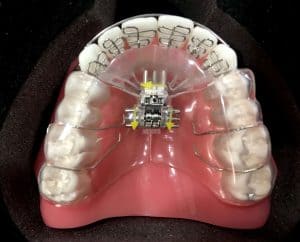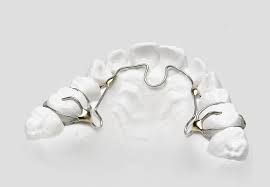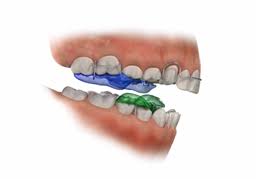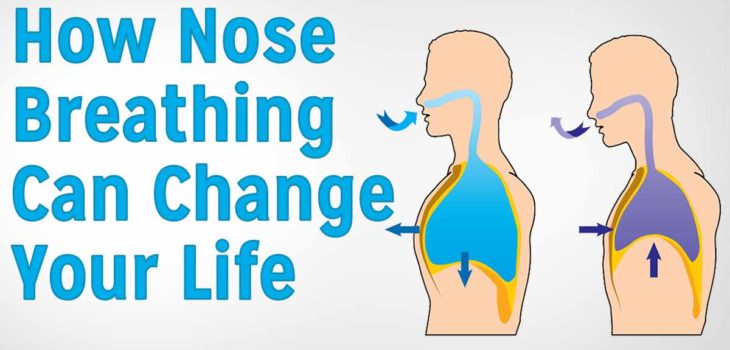Dr Gary Adams welcomes you to The Pediatric Sleep Apnea Center of Virginia. If your child is in need of orthodontics, or has pediatric sleep apnea or mouth breathing, you have come to the right place. Most of our patients are kids with crooked teeth, tied tongues, bad posture and mouth breathing habits. We help kids smile, bite, breathe, sleep and posture better. We integrate palatal expanders, posture correction, breathing exercises and myofunctional therapy. Our treatment helps kids develop a great smile, sleep better and live a healthier life. We are located in Vienna Virginia near Tysons Corner.

The entire point of orthodontic expanders is to achieve an attractive smile, right? Yes. But there are many important things to know when considering orthodontics and straightening teeth. Did you know that the following things are all linked and closely related:
- Straight teeth
- Jaw structure and facial profile, orthotropics
- Posture
- Healthy breathing patterns
- Overall health
What are palate expanders used for?
- Optimize facial growth, profile and smile esthetics
- Optimize tongue function
- Establish healthy breathing patterns
- Create a stable bite
- Balance the jaw and facial relationships
- help stablish healthy posture. Posture and jaw alignment are linked
Why teeth get crooked and crowded?
The reason why teeth become crooked and crowded is because of tied tongues and lips, and cheek/buccal ties, mouth breathing and a soft diet. This is why kids mouths and faces do not grow large enough for all their teeth to fit and bite properly. If tongue ties, lip ties and breathing problems are not corrected, your child’s facial profile and jaw structure will not grow big enough for all their teeth to fit. Not only will the teeth not be straight, but they will have poor facial profile, bite alignment and possibly even sleep apnea. Read about what causes tongue ties and lip ties. And what do tongue and lip ties look like anyway?
Tongue ties, lip ties need to be done with expanders
Even the best palatal expanders will not permanently fix the damage caused by lip and tongue ties. The tight muscles need to be released and retrained to function and posture properly. The retraining is called myofunctional therapy. If expanders are used and the ties and myofunctional therapy are not done, the child will fall behind in their development after appliance therapy. That is right, the teeth will get crowded and crooked all over again. Additionally the result will not be stable and the teeth and jaw structure will shift after even the best expansion and orthodontic treatment.
Lip and tongue tie release procedures with myofunctional therapy
Tongue and lip ties can be easily released using a laser. Lip ties can be released with very little myofunctional therapy. Tongue ties should not be released without pre and post myofunctional therapy. Tongues ties can sometimes reattach and be more restrictive than before without proper therapy.
Palatal expanders
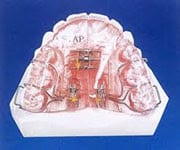
We prefer the use of the term “growth appliances.” They are small retainer-like devices that promote growth of the jaws. The goal is to grow the jaws into a more optimal size and shape. Teeth will have space to fit. The tongue will have room to move freely. And air will pass without resistance between the nose, mouth and lungs. Palatal expanders work by applying a light force in the direction the jaws need to grow. They are not mechanical devices and do not cause pain. The appliance mimics tongue pressure and encourages proper tongue position. Appliance therapy is synergistic with swallowing and tongue movement. Most kids only need to wear the our expanders at night for 6-9 months during treatment. The appliances are usually not worn during the day or while eating.
What age do kids get expanders?
The optimal age for kids orthodontic treatment is 5-13 years of age. The actual age will vary from child to child. But between ages 5-13 years of age, kids experience 80 percent of jaw and facial development. After age 16, the child will need to be treated as an adult. Adult treatments take longer and are more difficult, since adults faces are not growing any more. Also many adults start having problems with teeth clenching, TMJ, sleep apnea and bad posture.
What problems do expanders fix?
- Crowded and crooked teeth
- cross bite
- underbite
- deep narrow palate
- Poor Jaw and facial profile
- Mouth breathing
- Sleep problems
- Tied tongue and lip
Expanders are different than braces?
Traditional braces are for straightening teeth. Expander appliances grow the jaws to be a more optimal size and shape. Optimal treatment is to first grow the jaws to be the correct size and shape. And then straighten the teeth and balance the bite. Many times during expansion, the teeth will naturally get straighter and less crowded and crooked. Sometimes orthodontics is necessary after expanders, whereas in others, an acceptable cosmetic result can be obtained with expanders alone.
The Schwarz Expander
The Schwarz appliance is our favorite palatal expander for kids. The Schwarz is a removable appliance only worn at night. It is capable of growing the jaws wider, forward and taller. That is it can created 3D growth. When designed properly, it is especially good at getting the upper and lower jaw to move and grow forward. The Schwarz basically promotes growth of the maxilla and mandible (upper and lower jaws) in all directions. It is a highly customizable device. The Schwarz is very easy to tolerate because it is only worn at night. The appliance is removable and is taken out during the day and while eating. The Schwarz improves facial profile and promotes growth of other facial tissues such as lips, cheeks and nasal passageways.
The ALF Appliance
The ALF is the “advanced lightwire functional.” It is a light gauge wire that is very flexible and springy. The ALF typically stays in the mouth all the time and is not removed by the patient. It puts a constant outward springy pressure and its growth potential is aided by tongue function. The tongue pushes on the device and creates an increase in expansive pressure during swallowing and talking. The ALF is custom made to fit around teeth in narrow spaces. The device is especially helpful when there is sever crowding because it is so small. The ALF results in a decent amount of teeth movement and will usually need to be followed by conventional braces.
The Crozat
The Crozat expander looks similar to the ALF but it works a bit differently. The Crozat is better at expanding the posterior palate than the ALF. The wire is typically a heavier gauge. The wire crosses accross the back part of the palate whereas the ALF passes behind the front part of the mouth. The Crozat like the ALF uses tongue pressure to promote jaw development.
The Twin Block
The Twin Block appliance was Invented by Dr. William. The Twin Block consists of upper and lower appliances that work together to grow the jaws forward. The two devices work like lock and key and fit together very precisely when the patient bites down. The exact fit of the biting area on the Twin Block is what is used to promote the growth. We use the appliance in cases where the lower jaw growth is more difficult to achieve. This is called functional orthodontics and it is specifically used for retrognathia. Retrognathia is the technical name for a reverse position of the mandible.
The Hyrax is a Fixed Expander
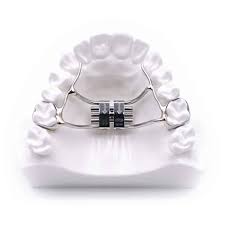
The Hyrax expander is very popular among orthodontists. It only expands the maxilla. It stays in the mouth all the time and cannot be removed by the patient. The Hyrax expands the back part of palate and really not the front part. This is a problem, because it does not create enough space in the front part of the mouth for the tongue to fit. The palate is also the base of the nose. One of the goals of our appliance therapy is to grow the base of the nose to improve nasal breathing.
The Hyrax is a “rapid palatal expander.” All the other appliances above are “slow expanders” that are capable of growing the mouth in several different directions outwards and forwards. They grow the mouth in a biologic shape that mimics the normal shape of the mouth and usual growth patterns. We do not use rapid palatal expanders because he slower expanders produce better results.
Rapid Palatal Expansion or Slow Biological Expansion
Rapid expansion uses a lot more pressure. During rapid techniques, appliances are adjusted at a rate of 1/4 mm per 3 days. Compared to slow expansion which is 1.4 mm of growth per 7-10 days. We believe slow expansion causes much less trauma and inflammation. The maxilla connects to 7 other facial bones and we believe heavier pressure placed on the other bones is not ideal. There is no reason to be in a hurry. Most of our kids appliance treatments last 6-9 months using slow expansion.
Removable and Fixed Appliances
Some orthodontic growth appliances stay in the mouth all the time hence the term “fixed.” Other appliances are removable and can be taken out of the mouth by the patient. Removable appliances are more comfortable because they do not get in your way while talking or eating. They are usually only worn at night time. Also, it is not always good to have an appliance in the way of normal forces places on teeth top to bottom. Biting pressure on the teeth keeps the upper a lower jaw bones in sync.
Specific Compared to Non-Specific Growth Expanders
Specific growth appliances are ones where a diagnosis is made about how much growth a child needs and the appliance is made to correct the deficiency. The Schwarz and ALF appliances are great examples. Myobrace and Healthy Start are expanders that are great for young kids who definitely need growth at a young age. The non-specific appliances are almost always a precursor to other appliances such as the Schwarz or conventional braces. Usually we prefer to use a specific growth expander when possible to avoid the need to 2 courses of treatment and more expense. Specific growth appliances require more expertise to design and adjust.
Myofunctional Therapy
What is a tongue tie?
It is a tight fiber that attaches the tongue to the front part of the lower jaw bone. The presence or absence of a tongue tie is not what is important. How well the tongue functions and moves is what matters. Tongue muscle tone, strength and range of motion are critical. Healthy swallow pattern. Can the tongue easily lift up into the palate and create an air-tight seal? Does the tongue have a wide shape and good tone during movement? Or does it get pointy and curl down when it is pushed out of the mouth?
What is wrong with a tied tongue?
Tied tongues do not move well. Tongue pressure during talking, swallowing and eating stimulates spacious development of the mouth, nose and face at a very young age. If the tongue cannot move well, the jaws and face will not grow large enough for healthy breathing patterns. People will have small breathing passageways. They will get choked by a large tongue especially during sleep. The tongue is the root cause of mouth breathing, airway resistance, snoring and many sleep problems.
What is Myofunctional Therapy?
Myofunctional therapy is basically physical therapy for tongues. Tongue function is evaluated. Exercises are given to improve tongue:
- Range of motion
- Strength and muscle tone
- Swallow patterns
- Formation of a seal on the palate
- Participation during healthy breathing patterns
When a tongue tie causes the tongue not to function properly, a qualified dentist and myofunctional therapist will order a functional tongue release procedure. A functional procedure verifies the tongue can move properly during the surgical procedure. Laser assisted techniques are done quickly, painlessly and without any bleeding. Success of the procedure hinges on the the tongue being untied and the patient performing myofunctional tongue exercises after the procedure.
Mouth Breathing vs Nose Breathing
Nasal breathing promotes healthy growth and development starting at a very young age. Nose breathing uses muscle groups in the abdomen, ribs, shoulders, neck and face. Healthy coordinated muscle patterns during breathing support good upright comfortable posture.
Mouth breathing uses a different muscle pattern than nasal breathing. Mouth breathing causes people to slouch and have forward head posture. People who mouth breath end up with small jaws, crooked teeth, poor airways, bad posture, sleep problems and bruxism. This is because muscle patterns used during mouth breathing causes the bones in the face, chest, back and neck to grow to be the wrong size and shape. Muscle pressure stimulates our bones to grow to a certain size and shape.
The tongue puts pressure on the upper jaw and teeth. The pressure promotes growth of a wider palate wider palate and upper jaw. The hard palate forms the base of the nose. As the palate grows wider, people can fit more air through larger nasal spaces. If enough oxygen fits through nasal spaces, it is not necessary to open the mouth to breathe. If the nasal passageways are too small, the mouth will need to open to meet oxygen demands.
